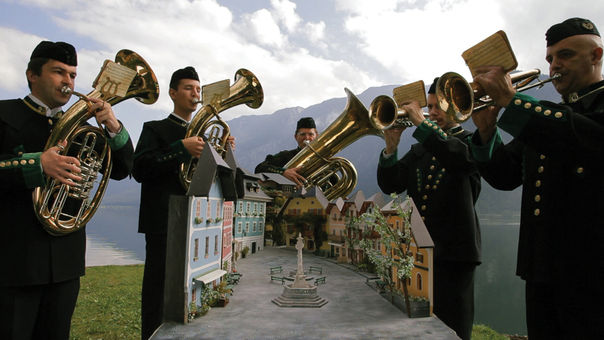The copied city
By Julieta Bilik From the film Double Happines by Ella Raidel

If in a brochure which promotes a Chinese pseudo-urban, pseudo-touristic project, Aryan and blond characters appear, then the question has been raised. Towards whom does China look as it builds itself into a world power? China’s style – always a singular one – is based on the idea of copy, of imitation, on producing the most accurate reproductions. Double Happines, the first documentary film by Ella Raidel, is built from this premise. Hallstatt is an Austrian dream town in between the mountains and next to lake, which welcomes tourists from all over the world and is a Unesco World Heritage Site. As part of its chaotic and raging urban planning, the Chinese went to visit the place, liked it and decided to build an actual-size copy of it. This is the original story. Setting off from this, the documentary combines ideal images (in scale models and 3D animations) with advertising fictions and observational recordings. With all this unusual beauty combined, the story takes shape as the images follow one after the other. And it gradually moves into something deeper as it goes beyond the anecdote, through the image’s surface. If, according to a Chinese accountant who copies images from his cellphone to sell to tourists, imitation is creation, what it left for innovation? For the original? A Chinese architect who speaks perfect English and admires the style of Manhattan criticizes imitation and blames it for destructing identity. He also wonders: what will the city of the future be like? And what should the Chinese remember about the cities they were born in? In this way, past, present and future get mixed up and are questioned through the subject of imitation. And Ella Raidel drives the spectator through the same road, through tricks of the image, the mise-en-scène (theatrical in its musical fragments) and the use of irony. In Double Happines, the mise-en-scène converses with the narration. Up front, visible, exposed and at times even exhibitionist, it reveals the artificiality of the construction of the Chinese identity. And uses the question of urban planning as an excuse. As if starting off from the premise “we are where we live”, Ella Raidel seems to want to unravel the Chinese essence. And, actually, what she discovers is that China wants to be as similar as possible to Europe. As if by being the other one could stop being the different one. Double Happiness also happens to be the design of a Chinese ornament commonly used as a decoration and as a symbol of marriage. It is perhaps because of this that Ella Raidel decides to insert scenes of young Chinese couples in their wedding photo shoots. That is where the spirit of the young generations is revealed: that of simulation, of the importance of beauty, of the image over the real. Like in social media, the young Chinese pose, put on makeup, smile, show off a shiny and happy life. But when the camera stops running the smile fades. And what is revealed is the plagiarism of happiness. Yes, as they say, behind appearances lies essence. China’s essence would be of those who pretend. And beyond their history they make a fiction of a past that does not exist. But do not be fooled. Ella Raidel is Austrian and her perspective on the Chinese matter is, at times, too European and rather ethnocentric. Though the documentary is worth watching so as to judge the issue with one’s own eyes.
Mariángela Martínez Restrepo Talent Press BsAs Coordinator/Editor Clara Picasso Text Translator

